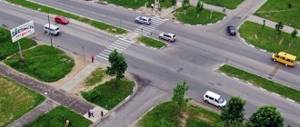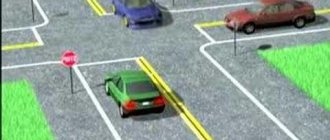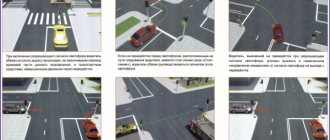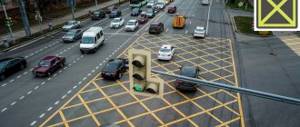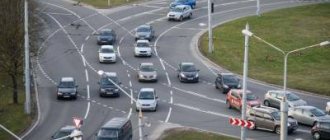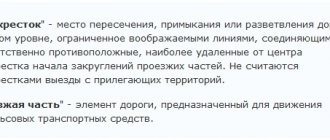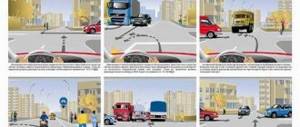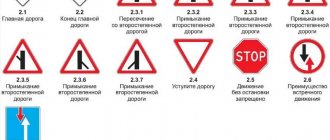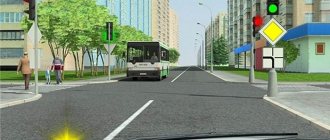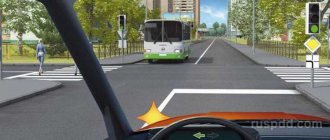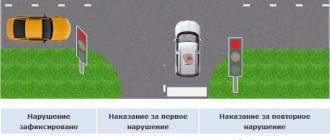Good afternoon, dear reader.
Today we will consider another controversial issue of traffic rules. We will talk about how to determine what is in front of your car: an intersection or an exit from the adjacent territory .
In fact, many drivers do not think about this issue until they find themselves in an ambiguous situation.
Let me remind you that the rules for driving through adjacent territories and intersections are somewhat different. For example, reversing at intersections is prohibited. The rules of priority when driving through equivalent intersections and exits from adjacent territories also differ.
In this article, we will look at signs that can accurately identify an intersection or surrounding area, as well as signs that do not give us any information about the roadway being crossed. Let's get started.
Concepts of intersection and surrounding area
Let's start by looking at the basic concepts that will be used in the article:
“Intersection” is a place where roads intersect, adjoin or branch at the same level, limited by imaginary lines connecting, respectively, the opposite, most distant from the center of the intersection, beginnings of curvatures of roadways. Exits from adjacent areas are not considered intersections.
“Adjacent territory” is the territory directly adjacent to the road and not intended for through traffic of vehicles (yards, residential areas, parking lots, gas stations, enterprises, etc.). Movement in the adjacent territory is carried out in accordance with these Rules.
So, according to these concepts, the main difference between an intersection and the surrounding area is the infrastructure facilities to which the intersecting roadway leads.
An example of an intersection (its panorama):
An example of the adjacent territory - leaving the yard (its panorama):
So, the two previous pictures did not cause you any difficulties, but in practice this is not always the case.
Stop line - line of entry to the intersection
The same cannot be said about the means of organizing traffic at road intersections. In particular, these are traffic lights and stop lines. And it is after crossing the stop line that the vehicle finds itself in the zone regulating the intersection of traffic flows; after crossing the stop line, the vehicle finds itself at the intersection
and after crossing the stop line at the traffic light regulating traffic through the intersection, the driver must apply the rules for driving through the intersection.
This relates directly to the task posed at the very beginning of the material.
Using the examples above, we determined that imaginary lines from the beginning of the curves of the roadway do not define the boundaries of the intersection; in some cases, they are simply impossible to construct. No curve, no intersection?
Agree, when you approach a road intersection, the question rarely arises whether it is an intersection or not, and if so, where are its boundaries? In the Rules of the Road, the term “intersection” is used to regulate the rules of movement at the intersection of roads, and not as an instruction for defining clear boundaries of the intersection.
In the Convention on Road Traffic, the definition of an intersection is more general.
| "Crossroads" in the Convention on Road Traffic |
| the term "intersection" means any grade crossing, junction or branch of roads, including the area formed by such intersections, junctions or branches; |
And no rounding. Entry, exit and movement through the intersection are regulated by a special chapter of the Traffic Rules. The driver does not need to imagine any lines to determine the boundaries. Curves on the roadway are just a symbolic designation of the area where traffic flows from different roads intersect.
Controversial road trips
Let's look at a couple of ambiguous situations (panorama 1 and panorama 2):
Look carefully at the pictures above and answer the question what is shown in each of them: an intersection or an exit from the adjacent territory?
Have you thought about it? Do you understand that everything is not so simple? In none of these examples is it possible to understand what is in front of us without taking the given exits. Those. The first conclusion that we will draw from the results of this article is that it is not always possible to understand what is in front of us: an intersection or the intersection of roadways.
Therefore, I propose to consider the signs that will help us further understand what kind of object is in front of us.
Uncontrolled intersections
Unregulated intersections are not always located at the intersection of two streets with little traffic. If a large number of cars are moving on the roads, then ideally, of course, there should be either a traffic light or a traffic controller. But in practice, intersections with active traffic often turn out to be unregulated. Accordingly, the number of traffic accidents on them is significantly higher, and they are quite dangerous.
An uncontrolled intersection is allowed only when a small number of vehicles pass through it.
Signs of an intersection
1. Traffic lights. Standard traffic lights, in accordance with GOST, are installed only at controlled intersections and controlled pedestrian crossings. They never regulate exits from adjacent territories.
2. Road signs 2.3.1-2.3.7 are installed only in front of intersections:
Also, sign 8.13 is installed only before intersections:
Please note that intersections have no other distinguishing features. For example, the “Give Way” or “Main Road” signs do not tell you anything specific, but more on that a little later.
The junction of the road is an intersection
Driving along highway No. 107 (21 km Volokolamskoye-Leningradskoye highway) towards Leningradskoye highway, I overtook the vehicle in front. Immediately after that he was stopped by a traffic police inspector.
I was charged with violating the traffic rules “Overtaking a moving vehicle while entering the lane of oncoming traffic within the coverage area of sign 3.20 “Overtaking is prohibited.” Explanation that overtaking was carried out in a place where the coverage area of sign 3.20 “Overtaking is prohibited” was interrupted because behind the sign I crossed two intersections, which the inspector did not take into account, explaining that these were not junctions of secondary roads, but exits from areas adjacent to the road. As a result, a report was drawn up and my driver's license was confiscated.
In accordance with the traffic rules, “The zone of validity of signs 3.16, 3.20, 3.22, 3.24, 3.26 – 3.30 extends from the place where the sign is installed to the nearest intersection behind it, and in a populated area, if there is no intersection, to the end of the populated area. The effect of the signs is not interrupted at points of exit from territories adjacent to the road and at places of intersection (junction) with field forest and other secondary roads in front of which the corresponding signs are not installed.”
However, the absence of priority signs 2.3.2 “Junction of a secondary road” at the intersections (Photo 2,3) is a violation of clause 5.3.5 of the “NATIONAL STANDARD OF THE RUSSIAN FEDERATION” (Appendix 1) namely: “It is allowed not to install signs 2.1, 2.3.1 -2.3.7 before exits of road intersections at different levels, as well as before junctions with paved roads, roads with unpaved surfaces, before junctions with exit roads from adjacent territories, if all of the listed signs of adjacent roads can be clearly recognized by drivers of vehicles following main road during daylight and dark hours.”
5.4.31 The effect of signs 3.16, 3.20, 3.22, 3.24, 3.26-3.30 extends from the place where the sign is installed to the nearest intersection behind the sign, and in a populated area, if there is no intersection, to the end of the populated area... These signs must be reinstalled after the end of the populated area or directly behind the intersection, if necessary, maintain the restrictions imposed by the sign installed, respectively, before the intersection or the end of the populated area.
In the traffic rules clause 1.2. the term “Intersection” is explained - “Exits from adjacent territories are not considered intersections” and “Adjacent territory” - the territory immediately adjacent to the road...” Dictionary of the Russian language, edited by S.I. Ozhegova, ed. 1963 p. 583 treats ch. “LIE-1. Sit down, lie down, tightly touching something.
2. To be located closely adjacent to something"
Neither the first nor the second roads (in the direction of travel) have signs of exits from “closely adjacent” territories (buildings, fences, barriers. Additional information signs (plates 7.1.1. - 7.2.6.). The nearest building, not visible beyond trees and bushes is located at a distance of 80-100 m from road No. 107.
Not being a local resident, while driving a moving car, it is impossible to assume (recognize) that adjacent paved roads equipped with signs, appropriate markings and fences are exits from the adjacent territory.
Taking into account the requirements of GOST R 1.0-2004, (Appendix 2), standardization is carried out in order to: - increase the level of safety; - create an evidence base and conditions for fulfilling the requirements of technical regulations, and also that they are “mandatory for compliance with direct instructions on this in the current legislation,” I believe that on the section of the road in question, the rules for the maintenance and installation of road signs were grossly violated - (GOST R 52289-2004), on the basis of which, in fact, the rules for the use of traffic rules road signs were drawn up, which complicates the road situation by introducing driver confusion.
The magistrate and district court objected “the sign must be observed” - imprisonment for 4 months. Please evaluate my chances for further struggle!
Signs of the surrounding area
The adjacent territory is not indicated by any road signs, so it can only be judged by the objects to which the road leads. For example, a gas station or parking lot may be located close to the road. These are adjacent areas.
However, it cannot be said that if there is a gas station on the side of the road, then you are driving into the adjacent territory. Let me give you an example to make this clearer:
Let's assume that our car is driving along a big road from right to left. At first glance, it may seem to the driver that the car leaving from above is leaving the gas station, i.e. leaves the surrounding area. In fact, this car is driving along a small road and arrives at an equivalent intersection. I think the idea is clear.
The second important conclusion: Not everything is adjacent to a gas station or a parking lot.
Rules for driving through an uncontrolled equivalent intersection
Driving through such an intersection must be done with caution, given that you can always meet a driver who has forgotten the rules or is confident that he is moving on the main road. When approaching an intersection of equal roads, remember that one rule common to all applies here: if you have an equal right to cross the intersection first, you must be guided by the “interference on the right” method. An exception to this rule is the tram, which has an absolute advantage over all road users
The exception to this rule is the tram, which has an absolute advantage over all road users.
There may be no sign before the intersection at all. This is rare, but all situations need to be considered. If the driver easily notices that there are no signs, traffic lights and traffic controllers, then it is not always possible to determine the road surface for the following reasons:
- if it rains;
- if snow cover covers the road;
- if there is fog outside the window;
- in the case when the driver does not understand the coatings.
What to do in these situations? When faced with such a problem, it is best to act as if you are on a secondary road, as this is the safest option.
Right turn
When turning right, you must act according to these rules:
- upon approaching an equivalent intersection, the driver must change lanes to the rightmost lane;
- pedestrians, cyclists on the bike path, and buses will have to give way;
- the vehicle’s trajectory must adhere to the extreme right side and essentially not interfere with other vehicles’ maneuvers.
Turn left and U-turn
When performing such a maneuver, you must give way:
- to all cars that are moving on the right along trajectories that coincide with yours;
- to all the cars that are moving towards you.
The last rule is typical for a reversal. Remember that this maneuver is the most dangerous and you need to be extremely careful.
Go straight
Such a maneuver will lead to the intersection of the paths of other vehicles at the intersection, so you need to be more careful when driving straight. You need to give way:
- cars making a right turn in the same direction, if the trajectories coincide;
- vehicles moving on the right to make a U-turn or turn left;
- the transport on the right follows straight ahead.
If you meet pedestrians on the way, give them the right of way as well. To avoid accidents, do not exceed speed and act with extreme caution. In all of the above cases, you cannot go to the intersection if there is a traffic jam at it
It is important to wait until the transport leaves
Even if the uncontrolled intersection has a roundabout, you must follow the same rules about obstacles on the right. Please note that rail transport has priority when moving in all directions. Today it often disappears from cities, and these rules are quickly forgotten by citizens
Confusing signs
Let's look at a few road signs that can confuse a driver:
Please note that the “Main Road” sign is installed not only in front of intersections, but also on other sections of roads. Those. in practice, a situation is possible when the main road sign is installed before leaving the adjacent territory.
As for the signs “Give way” and “Driving without stopping is prohibited,” they can also be installed at exits from adjacent territories.
The three listed signs will not help us in identifying the intersection or the surrounding area. Remember this.
Uncontrolled intersections
so UNT / Traffic rules / Lesson plans for traffic rules 7th grade
Lesson No. 5. Topic: “Types of intersections”
24.09.2013 40762 0
Lesson objectives:
Introduce students to the types of intersections and the rules for safely crossing the roadway.
Materials for the lesson:
Intersections and their types
The word crossroads is familiar to everyone. But, probably, you did not delve into its meaning, did not think about its meaning.
Crossroads
- a place where roads intersect at the same level.
It would be safer if the roads did not intersect at the same level, but passed one above the other. Then vehicles would not interfere with each other, their paths would not intersect, they would not waste time letting each other pass, and there would be no danger of collisions and run-overs.
Such intersections exist. They are called transport interchanges. But building them is very difficult and expensive. Therefore, there are still few of them, and most roads intersect at the same level.
There are different intersections. It depends on how the roads intersect with each other.
T-shaped three-way intersection.
Transport comes from three directions.
X-shaped four-way intersection. Transport comes from four directions.
Y-shaped three-way intersection. Transport comes from three directions.
| Multi-way intersection (intersection of more than two roads). Transport comes from many directions. | The square is an intersection of complex shape (the intersection of more than four roads). |
An intersection is not only a place where vehicles and pedestrians intersect; here vehicles turn left and right, and turn in the opposite direction. Their paths not only intersect with each other, but also intersect the paths of pedestrians.
To make traffic at an intersection safe, traffic lights and road signs are installed, road marking lines are applied to the roadway, and vehicles are equipped with special warning signals.
A pedestrian at an intersection, before starting to cross the street, must understand many things, including it is very important for him to know whether cars are going straight or turning. A pedestrian can learn about this from the drivers themselves. How?
Drivers use warning signals installed on vehicles to inform each other and pedestrians of their actions. These signals include direction indicator lights. They are commonly called "flashers" because they flash when turned on. If the driver turns on the left flasher, he warns about a left turn; he turns on the right flasher, he warns about a right turn. Using these signals, other drivers, as well as pedestrians, learn about the driver’s intention to go in one direction or another.
To make turn signals - “flashing lights” - more visible, three of them are installed on each side of the vehicle. In front there is a white light, on the side - yellow, in the back - yellow or red.
If vehicles do not have turn signal lights (for example, on bicycles) or are found to be faulty, turn signals must be given by hand.
Sound signals are also installed on vehicles. Sound signals are prohibited in populated areas. They can be used to prevent traffic accidents. This is also permitted on country roads. But if the road passes next to a hospital, sanatorium, rest home, kindergarten, etc., then sounding a sound signal may be prohibited on this section of the road, and then a road sign “Sound Signal Prohibited” is installed there.
If at an intersection there is neither a traffic light nor a traffic controller who would determine the order of movement of pedestrians and vehicles, then such an intersection is called uncontrolled. The pedestrian crossing located at such an intersection is also unregulated.
Let us consider in detail how to cross the road at a pedestrian crossing located at an uncontrolled intersection.
Let's start with the transition notation. It can be marked with “Pedestrian crossing” road signs, and sometimes, in addition to the signs, also with “zebra crossing” road markings.
If the pedestrian crossing at the intersection is not marked, then you need to cross the road along the line of continuation of the sidewalks. These lines are conditional, i.e. not indicated in any way, they should be carried out mentally.
The rules for crossing the road at an unregulated pedestrian crossing do not depend on how it is marked or whether it is marked at all.
The transition rules are always the same.
The transition symbols only serve to define its width.
If there is a zebra marking on a crossing, then it determines its width: the width of the zebra itself is the width of the crossing.
If the transition is indicated only by signs, then the width of the transition is equal to the distance between the signs.
If the pedestrian crossing at the intersection does not have any markings (pedestrians are allowed to cross the road along the sidewalk line), then the width of the crossing is equal to the distance between the conventional sidewalk lines.
Sometimes at an intersection there are barriers along the edge of the sidewalk that prevent crossing. Of course, crossing the road in such places is prohibited. It may be prohibited even in the absence of fences, if there is a sign “Pedestrian traffic is prohibited.” This is a round prohibition sign with a red border. A walking pedestrian is depicted on a white background, crossed out with a red line.
Consider an uncontrolled pedestrian crossing located at a regular four-way intersection.
You have come to an intersection. We determined by known signs where the pedestrian crossing was located. We stopped in front of the curb and analyzed what the intersection was like: in what directions are the vehicles traveling, where could the danger come from?
At such an intersection, vehicle traffic goes in four directions. Which vehicles are dangerous for you?
In the first part of the path along the transition, danger will only appear on the left. In the second part of the path there will be danger - only on the right.
Vehicles coming from the right can appear from three directions: directly to the right, on a right turn, and on a left turn. You already know how drivers use warning signals to report their actions.
In the second part of the path, only cars driving straight can create a danger on the right.
It can be seen that in one case the first part of the path across the road is easier, and the second is more difficult, and in the other, vice versa. However, in any situation, crossing the road at an uncontrolled intersection requires attention and responsibility.
When making a right or left turn at an intersection, the driver is obliged to give way to pedestrians crossing the street into which the car is turning. However, make sure that the driver gives way to you. If you are not sure about this, let the car pass yourself.
Sometimes you can see how at intersections some pedestrians, wanting to reduce the distance, follow the path shown in the figure.
This is a very risky path: for most of it, the pedestrian turns his back to the sides of the possible appearance of transport.
Those pedestrians who, at intersections formed by narrow “quiet” streets, do not cross the road as expected, but diagonally, right through the intersection, also behave unacceptable. The appearance of a car on a “quiet” street is always unexpected, and a pedestrian caught at an intersection behaves unpredictably: it is impossible for the driver to guess where he will run to escape the car. Most often, such cases end in disaster.
Rules for crossing the road at a pedestrian crossing at an unregulated intersection
1. Stop at the pedestrian crossing on the edge of the sidewalk, without stepping on the curb.
2. Look left and right. Determine in which directions vehicles are traveling at the intersection: are there any cars making turns in the direction of the pedestrian crossing.
3. Give way to all nearby vehicles.
4. Start crossing only at a safe distance from vehicles. Be aware of vehicles making turns!
5. Cross the roadway at a brisk pace, but not running.
6. While crossing, do not stop watching for vehicles on the left, and after the middle of the roadway - on the right.
7. Walk along the crossing at right angles to the roadway, and not diagonally, sticking to the right side.
Questions for consolidation:
1. In what places do pedestrians have the right to cross the roadway?
2. What types of intersections and ways of marking pedestrian crossings do you know?
3. What are the rules for crossing uncontrolled intersections?
4. What speed should a pedestrian choose when crossing the road?
